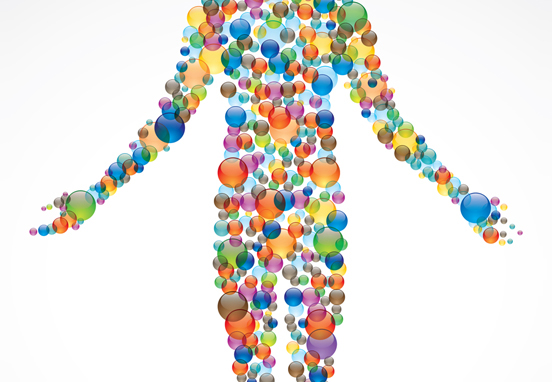Is there order in the chaos of the mind?

The human psyche is like a maze in which one can easily get lost.
Moods, thoughts, images and feelings alternate and determine our behavior.
We make decisions without understanding exactly why. We remain a mystery unto ourselves.
Is it possible to comprehend the inner workings in a simple manner and ultimately bring them into a livable balance?
Does what happens in us and in our lives make sense?
Is there recognizable order in the chaos of the psyche?
If we can find answers to these questions, then perhaps we could understand even deeper questions:
Is evil part of our human nature?
What share of the negative developments in the world can be attributed to our actions as individuals?
Once we understand ourselves better: could we live our personal lives and coexistence on the planet in a more conscious way?
A new view of mankind
IndividualSystemics provides us with a new view of the human psyche. It describes the fascinating world of a natural living system whose structure we can easily understand.
Any complex system in nature is composed of smaller systems.
Once we realize what components it consists of, we also understand the system as a whole.
A tree, for example, is not just simply a bunch of leaves, branches and roots. Its components are effectively organized and form a natural unit.
A number of trees combine to create a forest - this is the next higher level of organization. The trees build a larger system with new, even more fascinating interactions.
Similarly, the psyche isn't just simply made up of moods, thoughts, images and feelings. They are organized in an effective manner as well; and they too form natural units, which, like trees, belong to a larger whole.
You are Many
The human psyche is a self-organizing system. It produces parts that move quite independently of one another. Each of these inner parts is as intelligent and complex as a whole person. Therefore, IndividualSystemics also calls them Inner Persons.
The Inner Persons have different needs and abilities. This makes them specialists in dealing with life. Thus the psyche can adjust to many different situations.
But the Inner Persons are also amazingly self-willed. Each insists on its own point of view and has its own interests! This allows us to experience the world from different angles simultaneously.
There is only one problem: all of this is taking place almost entirely in the darkness of the subconscious.
The Inner Persons are not aware of themselves usually they don't know about each other.
In the darkness of the subconscious, they wrestle with each other to influence our decisions.
If one asserts itself dominantly, imbalance arises along with bias and internal stress.
If several are equally strong and are pulling in different directions, confusion, indecision or paralysis is a natural consequence.
By nature, the Inner Persons are in survival mode. Neither them, nor us as a whole are aware of this fact and its enormous consequences.
So how can we shed light on this darkness?
A blueprint of the inner world

We can imagine the inner world of a human being as a house where many people live. IndividualSystemics allows us to individually and intimately get to know all the inhabitants of the house. If everyone in the house knows each other and what influence they have there, it provides for conscious cooperation.
In our exploration, we don't proceed arbitrarily. We follow a plan that has been developed and proven over many years.
Let us first meet the Inner Person who can be also seen in real life first. Its task is usually to convey a friendly, approachable and normal impression.
At first glance, this Inner Person seems to be somewhat irrelevant. But it's worth spending time with it: every Inner Person has a surface and a core. The core is almost always subconscious. But only in its depths can we understand it completely. Then we see that each Inner Person is a complex and highly interesting creature.
We now proceed to the next Inner Person. It is located further back in the system. It is often very different from the person up front and usually more powerful.
Then we go yet another step further back and once again we see a big change and an increase in power.
Then we explore the space that is to the right and left of the center line.
As the process continues, the systemic connections become clear: Which group of Inner Persons forms the "Inner Government" and constantly determines my view of things? Who in me has no chance to have their say? Which Inner Persons love closeness and intimacy and who in me has the strength to compete in the world?
If we go about it this way, we can systematically and accurately explore the psyche - even its very subconscious areas. This research already reveals many surprises and can drastically change our view of ourselves.
But even deeper into the psyche, completely unnoticed by all, live the most secret Inner Persons. They have made a fundamental decision: to never be involved with people and life again. They actively and with great finesse avoid all contact. Thus, they can't be hurt anymore. They can maintain their will and enforce it indirectly. It is these Secret Power Parts that have the greatest impact on our inner and outer society. To find them and to bring them to consciousness is the most difficult part of the work. It requires a lot of dedication and love of the truth on the part of both the client and the facilitator.

The Five Languages of the Psyche
The Inner Persons are very similar to a whole person! Where does this similarity come from? The solution is simple: each Inner Person expresses itself simultaneously via the five levels with which also the whole person communicates:
Via the body.
Via feelings.
Via mental images.
Via thoughts and words.
Via energy.
Every person and every Inner Person constantly speak in these five languages. In this work the four non-verbal languages - body, emotion, symbols and energy – are just as important as the words.
If the dialogue with an Inner Person takes place at all five levels simultaneously, it leads us to its core. At its core, every Inner Person is at peace with itself and the world. Full of love it wants to bring itself back into coexistence.
The micro-structure of the parts
How exactly does dialogue with an Inner Person work?
The most important - and most challenging - tool in this process we call "like- to- like". It is the ability of the facilitator to answer a client and an Inner Person from a similar source inside himself. Answering doesn't mean mirroring or even imitating; it means engaging from a similar source in oneself. The facilitator is an important driving force in the dialogue - but on the terms of his counterpart.
You usually first meet an Inner Person on their surface. Like a bird that settles in the crown of a tree and only sees a tangle of leaves and branches, the facilitator first only sees content and behavior, but their deeper meaning is not yet visible.
With time, he will find the Inner Person takes on a certain attitude towards people, life and the world. From this position, the contents and behavior of the person inside arise. When the facilitator now responds to the Inner Person with a similar attitude, he explores the attitude and makes it more distinct, without changing it.
At the point of maximum clarity, a change occurs and the next lower attitude of the Inner Person becomes visible. Again, the facilitator reinforces and explores this attitude. Up to five layers of attitudes can be stacked up. We call these reactive attitudes because they are unconscious, automatic and persistent chronic reactions to people, life and the world. Only at its core can we find the original nature of the Inner Person - their essential attitude - and first here do we know, when looking at the overall picture of their attitudes, who it is.
And now the Inner Person itself understands who it is. It feels its original love and its original intent. A complete reversal takes place. Instead of defending its deep love, it now wants to give it away. It understands that it is only a part and wants to contribute to a successful life.
The Five Continents of the Psyche
In time, we discover recurrent patterns. We recognize that there are five archetypal species of humanity. We call them the Five Continents of the Psyche: Woman, Man, Child, Animal and God. The representatives of all five "Continents" live simultaneously in the psyche of each person - regardless of whether they are aware of it or not.

The Continent
Woman
Intuitive Intelligence Relationship, Creativity, Empathy

The Continent
Man
Rational Intelligence: Structure, Leadership, Foresight

The Continent
Child
Sensitive Intelligence Sensitivity, Closeness, Playfulness

The Continent
Animal
Instinctive Intelligence Perseverance, The will to survive, Territorial instinct

The Continent
God
Spiritual Intelligence Silence, Boundlessness, Unconditional love
Core balance in the inner system
The Five Continents of the Psyche include all the richness of our humanity.
If every Continent has the same right to development, a core balance ensues that is self-regulating.
When we suffer, it is a clear indication that our psyche is out of balance. The concept of the Five Continents shows us which Continent is not flourishing, and what we can do to find our inner wealth again.
The comprehensive self- reflection of the parts automatically leads to a core balance of the inner system. The natural side effects are: the willingness to do our best; the desire that everyone should prosper and the ability to easily give up self-serving prejudices. On this platform, a new relationship can arise which no longer focuses on survival, but the conscious organization of our individual life and contribution to a global community.
IndividualSystemics doesn't promise any quick fixes. It is a far-reaching long-term path to inner clarification and development. It is a comprehensive approach which does justice to all aspects of our complex and multifaceted nature.
The Intelligence of the Psyche
– how to discover its hidden order
"This book shows you the workings of your unconscious mind!"
New print and download out now!
























































